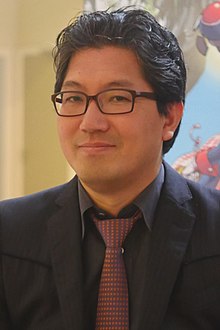Portal:Video games
The Video Games Portal

A video game or computer game is an electronic game that involves interaction with a user interface or input device (such as a joystick, controller, keyboard, or motion sensing device) to generate visual feedback from a display device, most commonly shown in a video format on a television set, computer monitor, flat-panel display or touchscreen on handheld devices, or a virtual reality headset. Most modern video games are audiovisual, with audio complement delivered through speakers or headphones, and sometimes also with other types of sensory feedback (e.g., haptic technology that provides tactile sensations). Some video games also allow microphone and webcam inputs for in-game chatting and livestreaming.
Video games are typically categorized according to their hardware platform, which traditionally includes arcade video games, console games, and computer games (which includes LAN games, online games, and browser games). More recently, the video game industry has expanded onto mobile gaming through mobile devices (such as smartphones and tablet computers), virtual and augmented reality systems, and remote cloud gaming. Video games are also classified into a wide range of genres based on their style of gameplay and target audience. (Full article...)
Featured articles –
The Lost Levels is similar to Super Mario Bros, with players controlling Mario or Luigi to rescue Princess Peach from Bowser. It adds a greater level of difficulty and Luigi controls slightly differently from Mario, with reduced ground friction and increased jump height. The Lost Levels also introduces obstacles such as poison mushroom power-ups, counterproductive level warps, and mid-air wind gusts. It has 32 levels across eight worlds and 20 bonus levels.
Reviewers viewed The Lost Levels as an extension of Super Mario Bros, especially its difficulty progression. Journalists appreciated the challenge when spectating speedruns and recognized the game as a precursor to the franchise's Kaizo subculture in which fans create and share ROM hacks featuring nearly impossible levels. This sequel gave Luigi his first character traits and introduced the poison mushroom item, which has since been used throughout the Mario franchise. The Lost Levels was the most popular game on the Disk System, for which it sold about 2.5 million copies. It is remembered among the most difficult Nintendo games. (Full article...)
Unlike many of its contemporary real-time strategy games, Sacrifice places little emphasis on resource gathering and management. There is no system of workers; the players' wizards collect souls to summon creatures, and their mana—energy for casting spells—constantly regenerates. Players customize their attacks by choosing from spells and creatures aligned to five gods. To defeat an opponent, the player's wizard sacrifices a friendly unit at the opposing wizard's altar, thereby desecrating it and banishing the enemy wizard. Aside from a single-player campaign, Sacrifice offers a multiplayer mode, in which up to four players can play against each other over computer networks.
Sacrifice was created by a small team of developers; most of the work was done by four key personnel. The graphic engine of the game uses tesselation: thousands of polygons are used to display an object and as lesser details are needed, the number of polygons is reduced. By adjusting the required level of detail, Sacrifice can be run on various machines with the highest possible quality of graphics. Complementing the graphics of the game were the voice work of professional actors, such as Tim Curry, and the musical compositions of Kevin Manthei. Sacrifice was praised by reviewers for the novel designs of its creatures and for its humorous content. The high level of attention needed to manage its frenetic combat was mentioned as a flaw. Despite winning several awards, Sacrifice was not a commercial success. (Full article...)
After developing Nintendo Entertainment System games in the 1980s, Rare, a British studio founded by Tim and Chris Stamper, purchased Silicon Graphics workstations to render 3D models. Nintendo sought a game to compete with Sega's Aladdin (1993) and commissioned Rare to revive the dormant Donkey Kong franchise. Rare assembled 12 developers to work on Donkey Kong Country over 18 months. Donkey Kong Country was inspired by the Super Mario series and was one of the first home console games to feature pre-rendered graphics, achieved through a compression technique that converted 3D models into SNES sprites with little loss of detail. It was the first Donkey Kong game neither produced nor directed by the franchise's creator, Shigeru Miyamoto, though he contributed design ideas.
Following its announcement at the Consumer Electronics Show in June 1994, Donkey Kong Country was highly anticipated and backed by a major marketing campaign that cost $16 million in America alone. It was released in November 1994 to acclaim; critics hailed its visuals as groundbreaking and praised its gameplay and music. Its quality and design were favourably compared to the Super Mario series. Donkey Kong Country received several year-end accolades and set the record for the fastest-selling video game at the time. With 9.3 million copies sold worldwide, it is the third-bestselling SNES game and the bestselling Donkey Kong game. Following the success, Nintendo purchased a large minority stake in Rare, which became a prominent second-party developer for Nintendo during the late 1990s. (Full article...)
The compilation was one of several ideas Rare considered to celebrate its 30th anniversary. Inspired by fans, upcoming Xbox One backward compatibility features, and a desire to link Rare's past and future, the company sorted through 120 games to choose those that best represented its oeuvre. It prioritized games with characters and environments original to the company. Rare incorporated four hardware emulators in the package, and worked with its parent company, Microsoft, to use its then-unannounced Xbox 360 emulation. Rare Replay released worldwide as an Xbox One exclusive on August 4, 2015.
Rare Replay's reviews were generally favorable. Critics appreciated the package's design and craft and called the release a new pinnacle for compilation releases. They commended its "rewind" and Snapshot features, but criticized technical issues in the Xbox 360 emulation and game installation. Among its games, reviewers preferred Rare's Nintendo 64 games, especially Blast Corps, and disliked Perfect Dark Zero, Grabbed by the Ghoulies, and the Spectrum games. Some outlets lamented the absence, due to licensing issues, of the Donkey Kong Country series and GoldenEye 007, while others thought the package was fine without them. Critics deemed the archival game content and developer interviews as among the compilation's best features, but were upset to see the content hidden behind time-consuming in-game challenges. Rare Replay became Rare's first United Kingdom all-formats charts bestseller since Banjo-Kazooie in 1998. (Full article...)
Did you know... -
- ... that fighting video game Panza Kick Boxing was endorsed by a French kickboxing champion who also supplied technical advice?
- ... that Terra Invicta's development company is a group of former volunteer video game modders that decided to release their own game after the success of their mod?
- ... that the concept of adding strippers to the extreme sports video game BMX XXX was initially proposed in jest?
- ... that the illustrations in the 1992 video game Tetris Classic are based on scenes from Alexander Pushkin's poem Ruslan and Ludmila?
- ... that the urban legend Herobrine was ranked on a Guinness World Records poll of the best video game villains, despite never existing?
- ... that the video game Fursan al-Aqsa received an update that allows players to reenact the October 7 attacks on Israel?
- ... that the 1979 video game Superman was one of the first console games with a pause feature?
- ... that for at least 90 minutes, Mori Calliope livestreamed herself begging video game developer Atlus to allow her to stream their game Persona 3?
- ... that the web-based video game Moderator Mayhem was based on a card game meant to demonstrate the difficulties of content moderation?
- ... that LittleBigPlanet, a video game that allows the player to create levels, coincided with the rise of user-generated content?
- ... that the 1987 video game Oriental Hero was panned as "so incredibly bad it's almost worth a look"?
- ... that a reviewer thought that the video game Robbery Bob contained cringeworthy dialogue?
Selected biography –
Selected image -
Recent video game-related events
- January 16, 2025 –
- Nintendo officially reveals the Nintendo Switch 2 video game console, the successor to the Nintendo Switch. (Nintendo)
- September 12, 2024 – 2023–2024 video game industry layoffs
- Microsoft announces that it will lay off 650 Microsoft Gaming employees as part of cuts to its workforce. (Variety)
- August 15, 2024 –
- American video game magazine Game Informer discontinues publication after 33 years. The magazine's website is also shut down. (BBC News)
Topics
Categories
Things you can do
In other Wikimedia projects
The following Wikimedia Foundation sister projects provide more on this subject:
-
Commons
Free media repository -
Wikibooks
Free textbooks and manuals -
Wikidata
Free knowledge base -
Wikinews
Free-content news -
Wikiquote
Collection of quotations -
Wikisource
Free-content library -
Wikiversity
Free learning tools -
Wiktionary
Dictionary and thesaurus














































